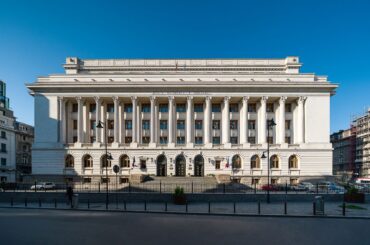In “Limits and pitfalls of QE in emerging economies”(OpiniiBNR, 14 August) I argued that, while central banks in advanced economies undertake quantitative easing (QE) in order to mitigate the shock of the Pandemic and the economic crisis, this kind of operations needs to be contemplated with caution in emerging economies. A reaction to my text suggested that the accumulation of net foreign assets (NFA) in emerging economies (EMEs) could be seen as a form of QE. I argue below that this is not an appropriate analogy. But first, I reiterate my view as to why EMEs have to treat QE with much caution.
- QE in emerging economies?
Emerging market economies(EMEs) have basic traits which asks for much caution in undertaking QE:
– Their central banks do not issue reserve currencies; this dents the efficacy and autonomy of monetary policy in dealing with severe shocks;
– Monetary policy can be weakened by the exchange rate risk, by insufficient trust in the local currency;
– The volatility of exchange rates in emerging economies does matter, the more so where dollarization/euroization is high. A flexible exchange rate can help in correcting imbalances, but it can also do harm when a massive depreciation entails substantial wealth and balance-sheet effects, intensifies currency substitution, and may cause inflation to get out of control.
– Local financial markets are frequenly quite thin and cannot absorb large issuances of sovereign debt. The exposure limits of commercial banks are to be considered as well.
– Although issuing debt in local currencies is preferable, a small size of local financial markets can force the issuance of bonds on external markets. And this creates a major vulnerability related to exchange rate dynamics.
– For weaker economies, the free capital movement can be a headache in moments of panic.
– Sudden stops can happen even when global financial conditions are relatively benign.
– QE in advanced economies can induce EMs to borrow too much as money is searching for higher yields. When conditions change, larger debts may find their servicing very costly.
EMEs that have been successful in reducing dollarization/euroization of their domestic transactions, where deficits are under control, with considerable sovereign bonds issued in local currency and plentiful foreign exchange reserves, can be more daring in practicing QE. They could also benefit on back ups, such as swap and repo lines arranged with reserve currency issuers. This room of manuever concerns the flow of liquidity on domestic markets and preventing excessive yields demanded by foreign lenders/investors, the easing of policy rates and of overall monetary conditions when interest rates fall in the global economy. But QE and monetization of deficits are fraught with major risks wherever deficits are large, external debts are considerable, and trust in the local currency is not sufficient.
Sovereign ratings illustrate macroeconomic situations, and the cost of issuing debt is indicative of national economic circumstances. Yield differentials for sovereign bonds and CDS term premia show that markets discriminate among EM, despite the easing of monetary and financial conditions worldwide. Therefore, caution must operate when contemplating dealing with the pandemic and the economic crisis by resorting to large fiscal stimuli and aggresive easing of monetary policy, to QE and monetization of deficits.
2. Why NFA accumulation is not a form of QE
There are, arguably, solid arguments why NFA accumulation should not be viewed as a form of QE. These arguments can be structured according to several criteria.
A question of purpose
Amassing NFA by central banks (CBs) of emerging economies (EMs) can very much reflect the need to bolster resilience in the face of extreme shocks. This is a stark lesson of the Asian crisis of more than twenty years ago,, when not public borrowing was the problem, but private borrowing.
Likewise, NFA accumulation can reflect also a strategy of enhancing competitiveness by maintaining undervalued exchange rates (import controls could be used too to this end). Undervalued exchange rates fostered sound trade balances in not a few Asian economies and higher NFA did not end up in dangerous overexpansion of base money. It may be that sterilization operations helped control the money supply.
Instead, QE in the US, In Europe, has been an attempt to deal with malfunctioning financial markets and, in the case of the euro area, to save it!
A question of “hard counterpart”
NFA are a “hard” counterpart to the rise in base money and can be used to withdraw base money should it be needed. When NFA go up, for various reasons, including due to massive capital inflows, CBs can sterilize, or use macrop-prudential policies to stem a massive rise in corresponding base money (the classical Tosowski dilemma) and, consequently, fuel inflation. CBs can sell NFA to absorb base money in case of need
A question of judgement: what is a normal expansion of base money and M2?
Whenever NFA accumulation illustrates sound economic growth and a corresponding expansion of base money and, relatedly, of the money supply, it does make sense –and it is clearly not QE.
A question of definition:
QE means injecting base money in exchange for all sorts of assets, including junk (fallen angels..) It is a sort of an extreme move on the part of some CBs, but which can afford it on a large scale. It can also imply monetization of debt, which is also possible for CBs in AE –and as the new monetary theory advocates.
A further question was whether an analogy can be made with the operations of the Swiss National Bank, which purchased a large volume of foreign assets in order to stem the appreciation of the Swiss franc. But the SNB does not enter the classification/cluster I have in mind, namely EMEs. SNB is very much like the Fed, ECB, BoJ, BoE. Besides, it caused great havoc in EU EMEs when it suspended its de facto fixed exchange rate with the euro, which had enticed many citizens and firms in those countries to borrow in Swiss francs as interest rates were much lower. The attempt to defend Swiss economy from a massive appreciation its currency, as many individuals and firms were fleeing the euro at the time (which made Mario Draghi to have his famous statement in 2012) explains what could be, wrongly, seen as QE on the part of the SNB. But it should rather be viewed it as a clear example of getting into competitive devaluation in the case of a safe haven currency. As Japan has been doing for decades now by injecting enormous quantities of base money in the Japanese economy (and monetizing government debt practically).
There is, however, a very interesting case, analogous to SNB: the Czech National BNK (CNB). It did almost exactly like SNB when it started to defend a certain level of its exchange rate, the crown, in order to protect the Czech economy from its currency considerable over-appreciation; to this end it bought massive amounts of foreign exchange reserves (euros) and, thereby, base money was injected in the Czech economy. Sterilization operations were quite likely quite muted for the CNB wanted to defend a level of the crown. The CNB got, therefore, also in the realm of competitive devaluation and managed floating was put on the shelf.
Could the absorption of EU funds in NMS be seen as a form of QE to the extent it implies accumulation of NFA and the creation of base money? When this accompanied by sound economic growth there is no reason to consider it a form of QE, as it does not fit several of the criteria mentioned above: purpose, definition and judgement.
For all the reasons mentioned above, NFA accumulation can hardly be seen as a form of QE in emerging market economies.




![Finance and democracy: a more complicated relationship than meets the eye[1]](https://opiniibnr.ro/wp-content/uploads/2025/03/democracy-7579742_1280-370x245.jpg)
